Dual SIM cell phones found their own niche in the industry and their number is growing rapidly. Most of these handsets are for the “low-end market share” and there is a solid demand for them among the consumers who want to save money on their mobile phone bills. Today, in our lab, we are going to abuse one of such dual SIM phones: LG GX200.
The handset is armed with only one radio module. It means that one of the SIM cards won’t be available when you speak on the phone. The GX200 is also equipped with a strong Li-Ion 1500 mAh battery and has the camera with LED flash.
In the small red and white box, as well as the phone itself, there is a charger, a data cable, a set of headphones and a manual (Pic. 1, 2). With its classic design the LG GX200 comes in the casing with chrome effect edging (Pic. 3, 4). The phone has a low display resolution (144 x 176 pixels).
Let’s start our tests.
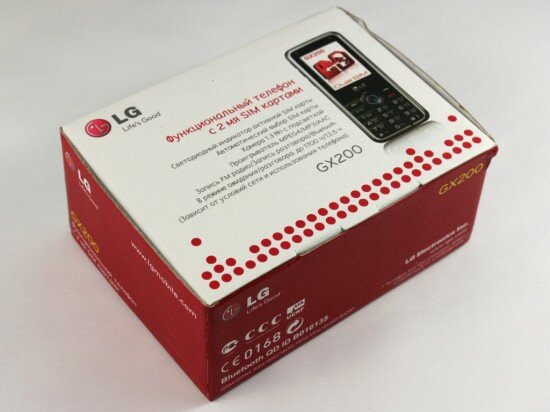
Рic. 1. Box
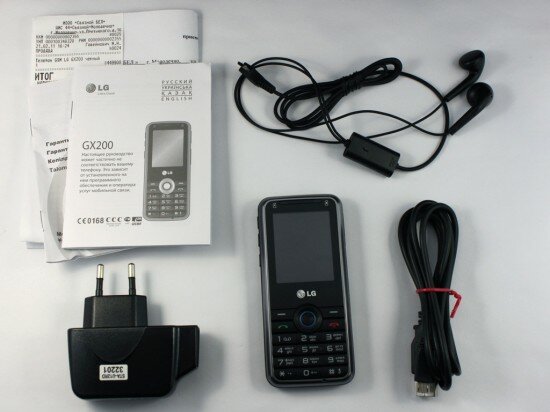
Рic. 2. Accessories

Рic. 3. LG GX200 (the front panel)
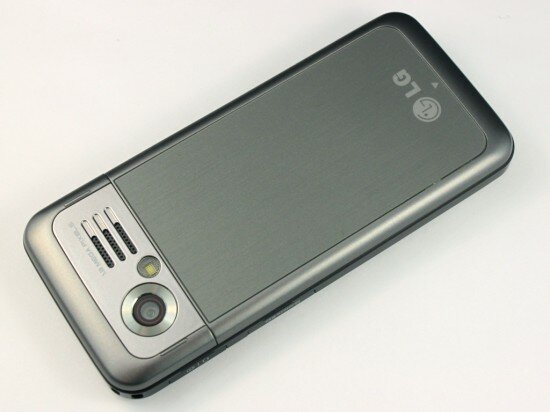
Рic. 4. LG GX200 (the back panel)
1. LG GX200 stress tests. Stage 1 — Light shocks
1.1 Drop test
People drop their handsets very often. But you shouldn’t worry much about this because most of the phones stay functional after knocks and bumps during our drop tests. It goes without saying that the results depend much on the type of floor on which you drop your handset. In this test, we successively dropped the LG GX200 on the carpet (video 1) from 1 m (3.28 ft) and on the ceramic tile (video 2) from 30 cm (11.8 inches).
The phone sustained no damage.
Video 1. Drops on the carpet from 1 m (3.28 ft)
Video 2. Drops on the tile from 30 cm (11.8 inches)
The grade for the drops on the carpet is 30 (with 30 being the highest possible grade)
The grade for the drops on the tile is 30 (with 30 being the highest possible grade)
1.2 Squeeze test
Sometimes people sit or step on their handsets accidentally. In this test we found out how the LG GX200 fares after such situations. We placed the phone on a table and applied a 3 kg (6.6 lbs) pressure from a wooden bar above it (Pic. 5).
The casing is flat. It has no protruding elements. The pressure was regularly distributed all over the phone. It helped him to stay functional.
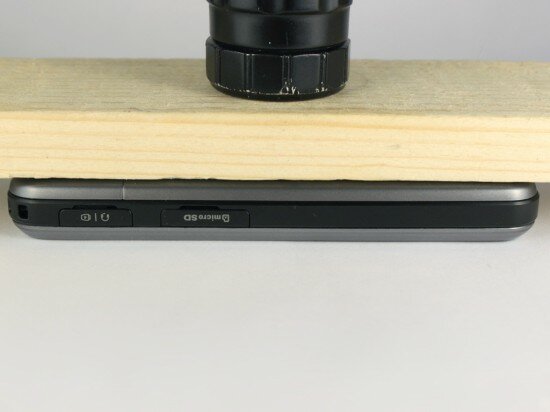
Pic. 5. The phone under the 3 kg (6.6 lbs) wooden bar.
The grade is 24 (with 24 being the highest possible grade)
1.3 Bend test
We use almost the same approach in the bend test. But the pressure is applied in a little bit different way. We put the LG GX200 onto the two planks so that each edge of the phone lies on a single plank. Then we hitched a string with 1 kg load (2.2 lbs) on top of the device.
The phone showed no sign of bend.
The grade is 24 (with 24 being the highest possible grade)
1.4 Durability test
We call it “the test of time”. During this test the phone will be scratched and scuffed by the things that people are used to keep in their pockets. Actually, we placed the gadget inside a drum together with keys, pennies, and plastic balls. The drum was rotated for 5 minutes (video 3).
When the test was over we examined the phone and saw many visible scratches and scuffs. The chrome effect edging was completely deteriorated (Pic. 6). Lots of small scratches appeared on the back cover (Pic. 7). We also saw many scuffs on the protective screen glass (Pic. 8).
Video 3. Drum rotation
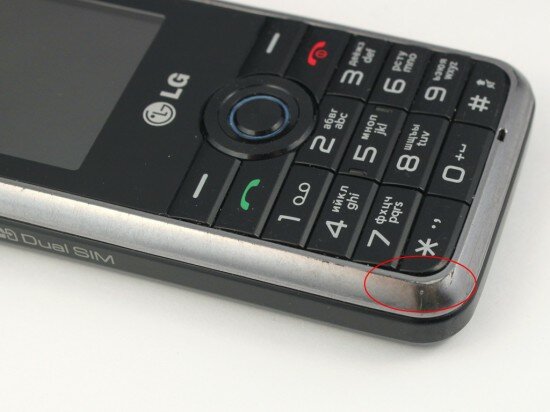
Pic. 6. Scuffs on the corners
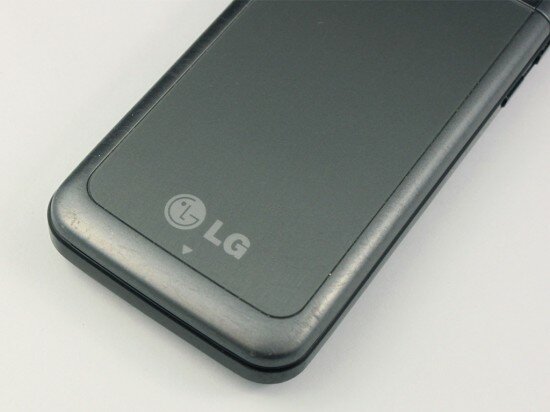
Рiс. 7. Here’s how the back cover looks after the test
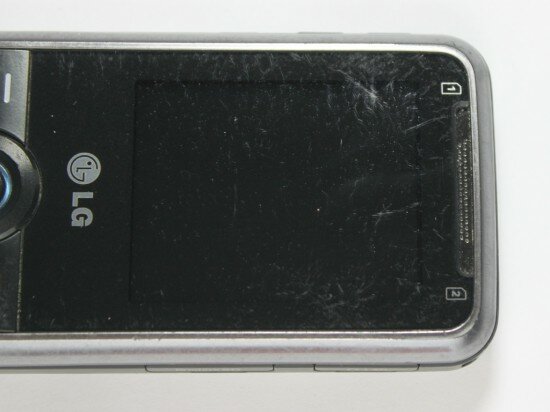
Рiс. 8. Scuffs on the screen
The grade is 10 (with 15 being the highest possible grade)
1.5 Scratch test
We tested scratch resistance of the LG GX200 with the help of a nail that was fixed to a plank. We put the phone under the nail and applied 100 g (0.22 lbs) pressure from this nail above the device. Then we took it immediately from under the nail so that the nail scratched the phone.
We scratched the screen and the back panel the following way (video 4). But they didn’t sustain any scratches.
Video 4. Back panel scratching
The screen gets 15 points (with 15 being the highest possible grade)
The back panel gets 15 points (with 15 being the highest possible grade)
1.6 High temperature
In this test we found out how the LG GX200 operates after being exposed to high temperatures. We placed the device in a metallic container 5 cm from the electric bulb (40 Wt) that heated the phone for 3 min. (video 5).
The temperature of the handset rose to 80 °С (176 °F) that is too little to cause any harm.
Video 5. Heat test
The grade is 12 (with 12 being the highest possible grade)
1.7 Dust test
As time goes by, more and more dust and dirt penetrates your cell phone and accumulates inside. But the phone stays absolutely functional. Sometimes small grains of dust or sand penetrate under the protective screen glass and ruin the quality of the picture. The phone’s appearance also changes much for the worse. If dust penetrates the keyboard some keys and even all the keyboard may stop working.
In order to check the LG GX200’s dust resistance, we took an enclosed tray containing dust and threw the phone inside it. Then we made it vibrate viciously for 2 min.
Here’ how the handset looked like after the test (Pic. 9). There wasn’t very much dust in the battery slot (Pic. 10). The connector showed even better result: it was almost clean (Pic. 11). The keyboard worked fine besides the asterisk key and the pound sign that became a bit stiffer. Soon all the keys performed perfectly again.
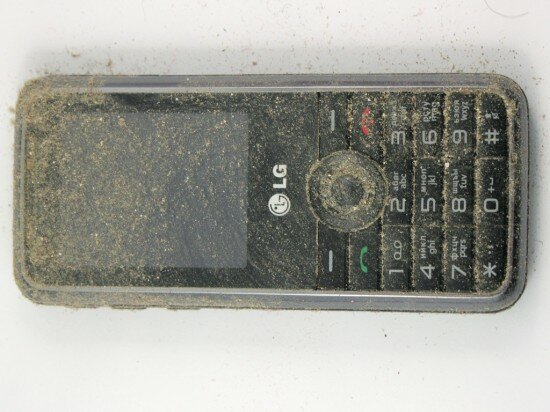
Pic. 9. Here’ how the handset looked like after the test

Pic. 10. Dust in the battery slot

Pic. 11. Here’ how the connectors looked like after the test
The grade is 12 (with 12 being the highest possible grade)
1.8 Signal strength test
As we said before, the phone has only one radio module. It means that it cannot work with both SIM cards simultaneously. In this test we check the reception and call quality of the phone. We placed the handset inside a box (video 6). Then we foiled the box. The foil blocked the signal between the phone and the cell tower. However, we made a hole in the top part of the box through which the signal could be obtained. Finally, we started calling.
From the video you can see that the set of bars on the phone’s screen displays the full strength of the signal. The LG GX200 received all incoming calls.
Video 6. Signal strength test
The grade is 15 (with 15 being the highest possible grade)
After the 1st stage of the stress tests, the LG GX200 got 187 (with 192 being the highest possible grade)
2. LG GX200 stress tests. Stage 2 — Tough conditions
2.1 Drop test
We increased the height of the drops: from 1.5 m (4.9 ft) on the carpet (video 7) and from 50 cm (1.64 ft) on the tile (video 8).
The phone showed no damage after the drops on the carpet. But after one of the drops on the tile the back cover and the battery fell off. There was nothing serious and the phone survived with no problem.
Video 7. Drops on the carpet from 1.5 m (4.9 ft)
Video 8. Drops on the tile from 50 cm (1.64 ft)
The grade for the drops on the carpet is 30 (with 30 being the highest possible grade)
The grade for the drops on the tile is 30 (with 30 being the highest possible grade)
2.2 Squeeze test
At the second stage of this test we applied 10 kg (22 lbs) pressure from the wooden bar above the phone. The moment we placed the bar on the phone we heard an unpleasant sound produced by the grains of dust and sand that penetrated the phone during the dust test. That was the only disappointment. The phone sustained no damage.
The grade is 24 (with 24 being the highest possible grade)
2.3 Bend test
This time, we increased the load by 5 times compared to the previous test.
5 kg (11 lbs) was enough to bend the the LG GX200. But the phone showed no visible harm.
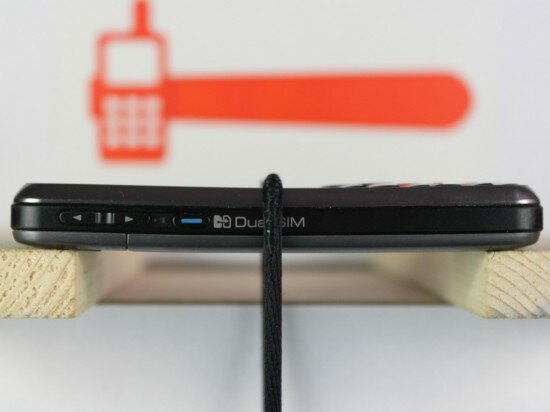
Рiс. 12. Bend that is caused by the 5 kg (11 lbs) weight
The grade is 24 (with 24 being the highest possible grade)
2.4 Durability test
We increased the time that the LG GX200 spent in our self-made “time machine” to 10 min.
The appearance of the gadget changed much more for the worse. We saw a lot of new scratches and scuffs on the edges and on the screen. The paint on the back cover started to peel off (Pic. 13). Some visible scratches also appeared on the keyboard (Pic. 14).
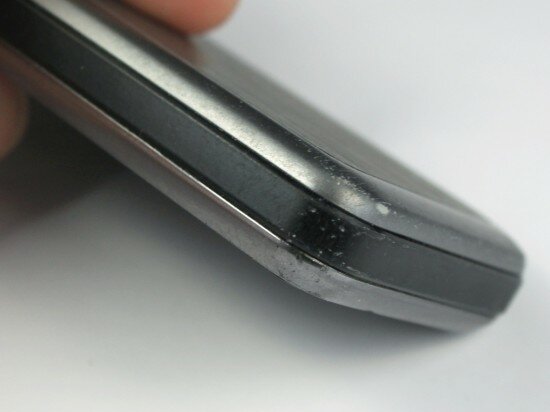
Рiс. 13. Scuffs on the corners
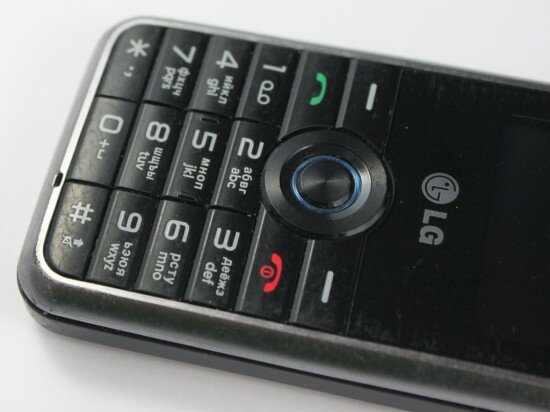
Рiс. 14. Scuffs on the keyboard
The grade is 10 (with 15 being the highest possible grade)
2.5 Scratch test
We increased the force of scratches to 300 g (0.66 lbs) (video 9, 10).
After the test there was a visible scratch of a medium depth on the screen (video 9). The back cover sustained a minor scratch that was also visible (video 10).
Video 9. Screen scratching (the force of scratches is 300 g (0.66 lbs))
Video 10. Back cover scratching (the force of scratches is 300 g (0.66 lbs))
The screen gets 10 points (with 15 being the highest possible grade)
The back cover gets 10 points (with 15 being the highest possible grade)
2.6 Freeze test
In this test we placed the LG GX200 in a freezer for 2 hours for the sake of science. The handset was left in speaking mode during that time. Our aim is to find any possible problems that can be caused by the cold.
When the time of the test was over we took the phone out of the freezer (video 11). As you can see from the video the battery stayed full. The display and the keyboard also worked pretty fine. So you can speak on your GX200 for 2 hours in the cold and not be afraid of anything.
We have to infer that the gadget is able to survive any winter. The keys are so large that you can dial telephone numbers wearing gloves with no problem (well, perhaps, in the nearest future we’ll introduce a new test: how to use a cell phone with the gloves).
Video 10. Freeze test
The grade is 18 (with 18 being the highest possible grade)
2.7 Heat test
This time the phone lay in the “sun” a little bit more than 5 min.
The temperature of the gadget rose to 100 °С (212 °F) but the plastic casing didn’t melt and the colour rendering stayed fine.
The grade is 12 (with 12 being the highest possible grade)
2.8 Immersion in water
You should always protect your cell phone from getting wet. Even one drop of water can kill it. At the same time your handset can lay at the bottom of a pond for a few minutes and stay absolutely functional. It depends on the phone and on how lucky you are.
In this test, we dunked the LG GX200 under water for 1 second (video 12).
The period of the test was too short to cause any damage. But the sound that was coming out of the speakers became very quiet. The battery slot was dry. We only saw some drops of water on the battery. The connectors also stayed dry – the cap did its job.
After the test we dried the phone out.
Video 12. Immersion in water for 1 second
The grade is 30 (with 30 being the highest possible grade)
2.9 Dust test
We increased the time of the vibration to 5 min.
As a result, a lot of dust stuck in the loudspeaker grill (Pic. 15) and we had to work hard to get rid of it. We also found out that the battery slot and the connectors were dirtier than in the previous test (Pic. 16). The keys became stiff again. We didn’t feel any audible feedback provided when we pressed the pound sign.
We should also say that the keys started to work fine after the durability test.
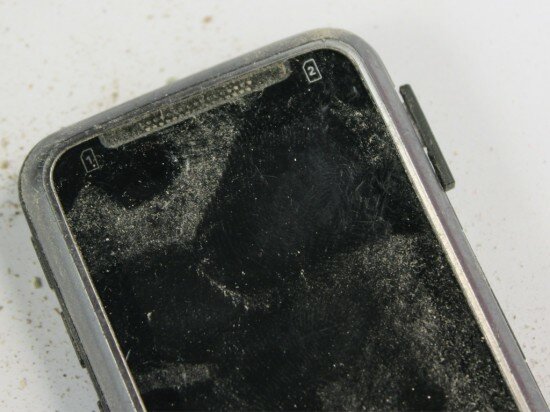
Рiс. 15. The loudspeaker grill
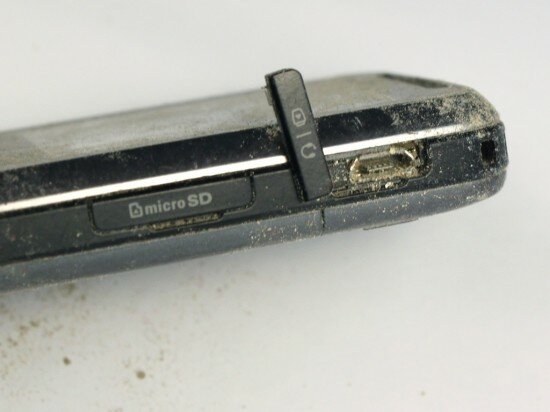
Рiс. 16. Dust in the battery slot
The grade is 12 (with 12 being the highest possible grade)
2.10 Signal strength test
At the 2nd stage of this test, we decreased the size of the hole to 20 x 20 mm (0.787 x 0.787 inches) with the help of the template (video 13).
Despite the poor reception conditions, the set of bars on the screen displayed the full strength of the signal. The phone received all incoming calls. None of the calls was dropped.
Video 13. Signal strength test
The grade is 15 (with 15 being the highest possible grade)
After the 2nd stage of the stress tests, the LG GX200 got 225 (with 240 being the highest possible grade)
3.LG GX200 stress tests. Stage 3 — The toughest conditions
3.1 Drop test
At the last stage of this test, we dropped the phone on the carpet (video 14) from 2 m (6.56 ft) and on the tile (video 15) from 1 m (3.28 ft).
The gadget sustained no damage. But after one of the drops on the carpet the back cover was removed.
Video 14. Drop on the carpet from 2 m (6.56 ft)
Video 15. Drop on the tile from 1 m (3.28 ft)
The grade for the drop on the carpet is 30 (with 30 being the highest possible grade)
The grade for the drop on the tile is 30 (with 30 being the highest possible grade)
3.2 Squeeze test
At the last stage of the squeeze test, we increased the pressure we applied to 20 kg (44 lbs).
The phone passed this test with no problem.
The grade is 24 (with 24 being the highest possible grade)
3.3 Bend test
We applied 10 kg (22 lbs) weight in our attempt to bend the LG GX200.
The bend was significant (Pic. 17) and we were really surprised that the phone stayed functional after such a tough test.
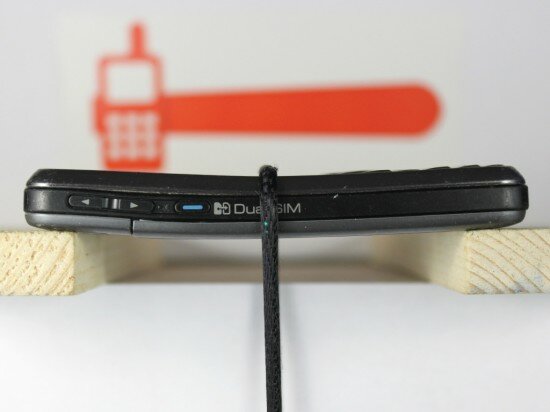
Рiс. 17. Bend caused by the 10 kg (22 lbs) weight
The grade is 24 (with 24 being the highest possible grade)
3.4 Durability test
In this experiment, the drum was rotated for 20 min.
More visible scuffs and scratches appeared on each face, edge and corner of the phone. The chrome effect edging was completely scratched on the corners (Pic. 18). The corners of the back panel were also completely scuffed up in some places (Pic. 19). Scuffs on the screen ruined the picture (Pic. 20).
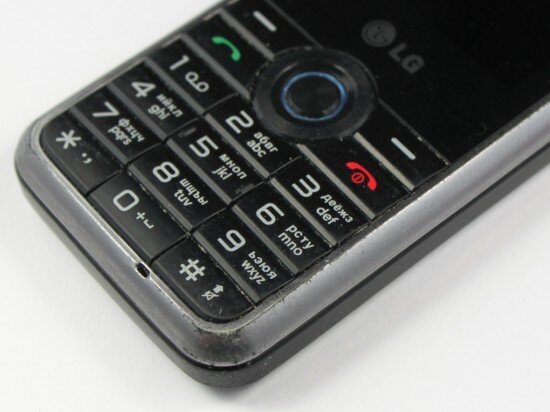
Рiс. 18. Scuffs on the corners
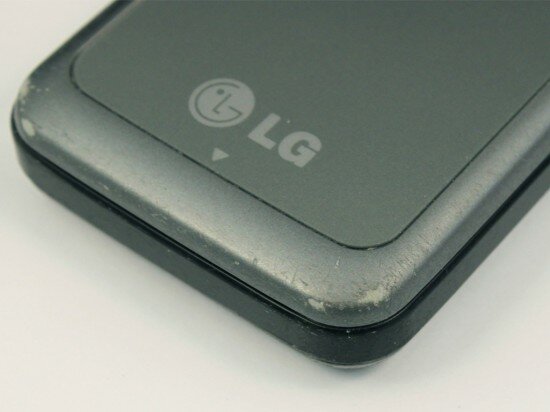
Рiс. 19. Here
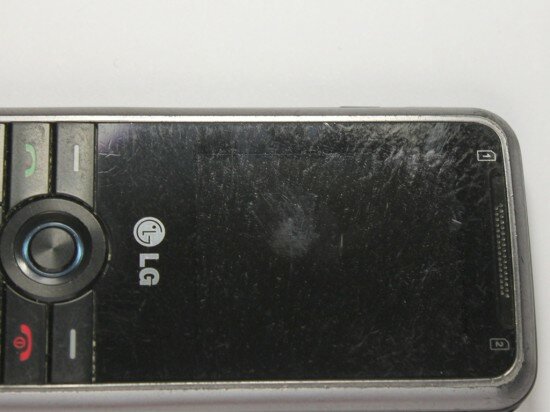
Рiс. 20. Here
The grade is 10 (with 15 being the highest possible grade)
3.5 Scratch test
We successively applied 600 g (1.322 lbs) pressure from the nail above the screen and the back panel of the phone (video 16, 17).
This time, the screen sustained a deep scratch (Pic. 21, 22) that ruined the picture greater than the scratch in the previous test. The back panel also showed a deep scratch (Pic. 23).
Video 16. Screen scratching
Video 17. Back panel scratching
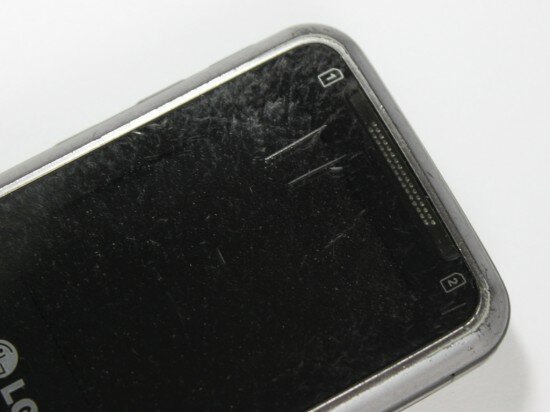
Рiс. 21. Scratch on the screen
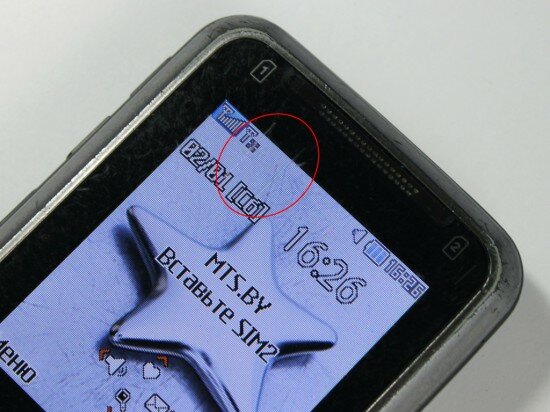
Рiс. 22. Here
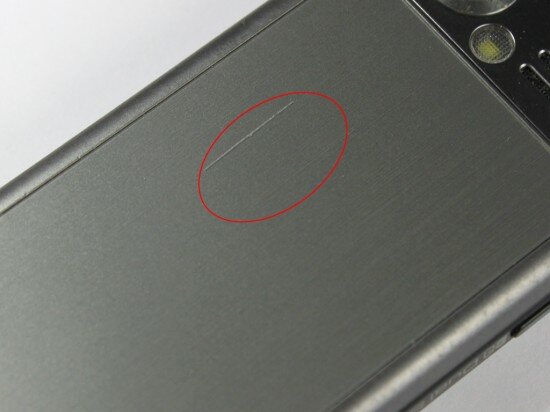
Рiс. 23. Scratch on the back cover
10 points for the screen (with 15 being the highest possible grade) for the screen
10 points for the back cover (with 15 being the highest possible grade) for the back cover
3.6 Heat test
At the last stage of this test, we increased the time of the phone’s heat exposure to 10 min. (video 18).
The temperature of the gadget rose insignificantly (102 °С or 215.6 °F). However, not only the phone’s exterior parts became so hot. The phone was also very hot inside. The display became dark and the picture restored just in front of our eyes. A lot of small cracks appeared in the lower part of the screen (Pic. 24). They were visible in the bright lights and inconspicuous in dim light. The keyboard worked fine. But we couldn’t touch it because it was too hot.
Video 18. Heat test
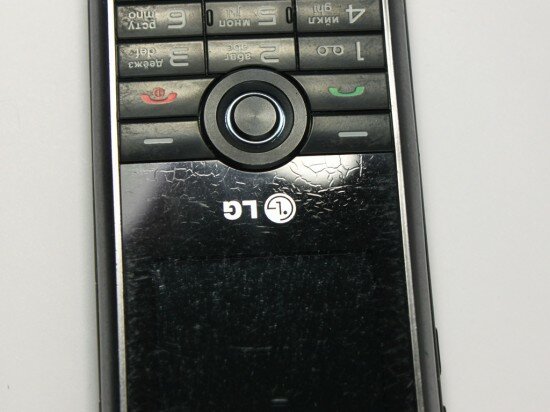
Рiс. 24. Cracks on the screen
The grade is 8 (with 12 being the highest possible grade)
3.7 Immersion in water
In this test, we dunked the LG GX200 under water for a longer period: 20 sec. (video 19).
The phone performed as fine as later (but the sound coming out of the speakers became quiet again). This time, water penetrated under the battery and, perhaps, the circuit board got wet. The connectors stayed dry (Pic. 25).
We restored the sound from the speakers by drying the phone out.
Video 19. Immersion in water for 20 sec.

Pic. 25. The connectors stayed dry
The grade is 30 (with 30 being the highest possible grade)
3.8 Immersion in beer
Cell phones can come in contact not only with water. Sometimes people pour tea or, for example, juice on their handsets. But we dunked the GX200 under beer for 10 sec. (video 20).
This popular alcoholic drink didn’t damage the gadget. The beer penetrated the phone as much as water in the previous test.
After the experiment, we washed and dried the phone. Then we examined the LG once again. It performed fine.
Video 20. Immersion in beer for 10 sec
The grade is 9 (with 9 being the highest possible grade)
3.9 Dust test
At the last stage of the dust test the tray was vibrated for 10 min.
This time, more keys became stiff. Dust penetrated even under the D-pad. When we started to clean the phone we saw a few small grains of dust under the protective screen glass (Pic. 26). The speakers started to sound worse.
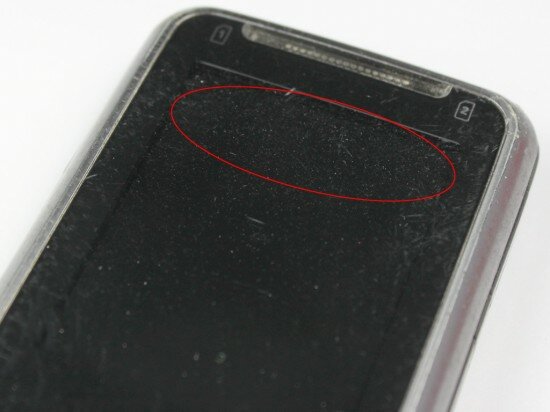
Рiс. 26. Dust under the protective screen glass
The grade is 8 (with 12 being the highest possible grade)
3.10 The keyboard
The LG GX200’s keyboard is made of a relatively soft plastic material that is not durable.
During the tests, dust penetrated under the keyboard and made it stiff. It was really hard to press some of the keys. However, all the dust was shaken off the phone each time when took the gadget out of the drum (our self-made “time machine”). Actually, the same would happen after a few hours of use.
Extremely high and cold temperatures didn’t break the keyboard. It also stayed functional after the immersions in water and in beer.
The keyboard never malfunctioned during all the stress tests. .
The grade is 20 (with 30 being the highest possible grade)
3.11 Signal strength test
The minimal dimensions of the hole of the shielded box are always 15 x 15 mm (0.59 x 0.59 inches) (video 21).
The number of bars in the indicator of signal strength fluctuated from maximum to minimum. One of the 10 incoming calls wasn’t received by the phone. The reply was “the subscriber is not available”.
From the results of this test we can infer that the number of bars on the LG GX200’s screen doesn’t show the real strength of the signal. This is not only due to the signal reduction between the phone and its network but also due to the weak antenna signals on the LG itself. The phone couldn’t connect to its network because of the foiled box that served as the obstruction.
Video 21. Signal strength test
The grade is 10 (with 15 being the highest possible grade)
3.12 Short circuit and overcharge
In this test we check how the LG GX200 survives short circuits and overcharges.
We tested the battery charger at first. We made a short circuit of the power supply terminals with the help of the forceps for 1 sec. (video 22).
The short circuit didn’t break the battery charger and the phone performed and charged with no problem.
Video 22. Short circuit of the battery charger
Then we shorted the battery for a moment (video 23).
This test resulted in a spark. But the battery stayed functional. Few of us know that a small chip inside a battery protects its innards from short circuits.
Video 23. Short circuit of the battery
Next, we checked the reaction of the LG GX200 to the increase in charging voltage. We plugged the battery charger in the PSU and raised the voltage from 5 to 8 V (video 24).
When the voltage reached 6.8 V the phone gave a warning that the charging was stopped. But judging by the current, the phone was still being charged. Further raise of the charging voltage increased the current to 1.5 A. This caused a lot of problems later. Moreover, we saw the smoke coming out of the top part of the phone when the voltage reached the critical point.
Then we decreased the charging voltage in order to find the point at which the phone would not consume any current. But the PSU displayed 110 mА. Evidently, something went wrong with the charging circuits. Though the GX200 could be charged it was dangerous to do it.
Our advise: never use cheap Chinese battery chargers if you want to charge your LG GX200 successfully and avoid the problems that we had.
Video 24. Increase/decrease in charging voltage
We have almost destroyed the charging circuits. Now it’s time for the power circuits. The approach of the final test is almost the same. We took the battery out and plugged the PSU in the phone’s connector (video 25).
We took 7 V as a critical point in this test. So we started to increase energy supply. Though we didn’t see any smoke the result was appalling: the phone continued to consume 110 mA of energy when it was switched off. It meant that the 1500 mAh battery would be empty in less than 24 hours.
In this test we checked the phone’s technical state. Such things as overcharge and short circuits rarely happen in real life situations. But we saw some mobile phone users who powered their gadgets with the help of the non-standard supply units. And they plugged them directly into their handsets. Anyway this test showed that the GX200’s charging circuits and power circuits are not reliable.
Video 25. Increase in energy supply
The battery charger (short circuit) gets 15 (with 15 being the highest possible grade)
The battery (short circuit) gets 15 (with 15 being the highest possible grade)
The grade for the increase/decrease in charging voltage is 5 (with 15 being the highest possible grade)
The grade for the increase/decrease in energy supply is 5 (with 15 being the highest possible grade)
3.13 Disassembling
It’s time to take the LG GX200 apart and see the innards. We only had to drive off 4 screws in order to disassemble this device (Pic. 27).
Despite its relatively low price, the LG GX200’s build quality is fine enough. The keyboard is attached to a separate board that makes it impossible to bend the circuit board while pressing the keys (some people press the keys too heavily). The circuit board, by the way, is smart and compact. It occupies the whole space of the phone (Pic. 28, 29). Almost all the components of the board are protected by the two removable shields. The mini-USB port is soldered to the board with the help of the steel clamp. The most important chips are compounded.
The only disadvantage is the absence of the steel frame that could make the casing more rigid.
We found the component of the phone that was burnt when we raised the charging voltage. It was the stabilitron of the USB circuit (Pic. 30).
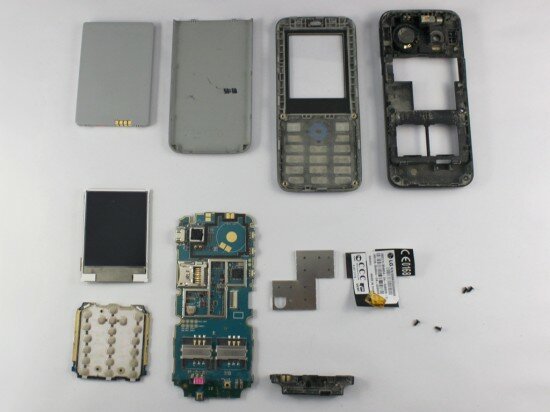
Рiс. 27. The LG GX200 disassembled
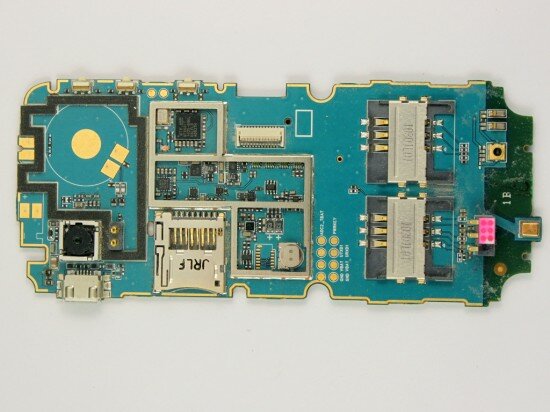
Рiс. 28. The LG GX200’s circuit board
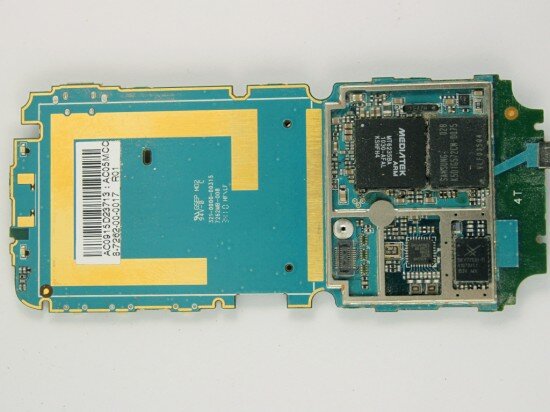
Рiс. 29. The LG GX200’s circuit board (the front side)
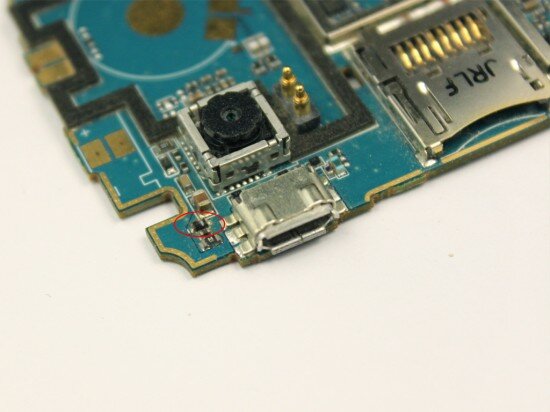
Рiс. 30. The burnt component
The grade is 30 (with 30 being the highest possible grade)
After the 3rd stage of the stress tests, the LG GX200 got 293 points (with 351 being the highest possible grade)
Final words
The phone showed average results in this stress test. Taking into consideration the price, the dual SIM function, long battery life and the grades for the tests, the LG GX200 is a reliable cell phone that has a good value for money.
It goes without saying that this model can’t be called successful because of the number of disadvantages that we found during our tests.
Here’s a list of the disadvantages in order of decreasing importance:
- The casing is not scratch resistant. We think that in half a year the appearance of your GX200 will be changed much for the worse.
- The LG can’t be charged with the help of non-standard battery chargers. You can even break the phone if you plug a PSU in it and raise the charging voltage. The same can be said about the phone’s power circuits.
- It’s quite easy to bend the casing. Though the handset survived all the bend tests, there is a possibility of different problems with its performance, especially if you care it in your hip-pockets for a long time.
- The LG GX200 is not so dust resistant as some of the phones that we tested before.
That’s all. Thank you.
The GX200 has the following advantages: the phone survives drops and cold weather. Although this is not a water resistant gadget, it successfully passed the water and beer tests.
As for the heat test and reception quality, the LG showed average results.
Here’s how the phone looks like after all the tests (Pic. 31, 32, video 26).
Video 26. Here’s how the phone looks like after all the tests
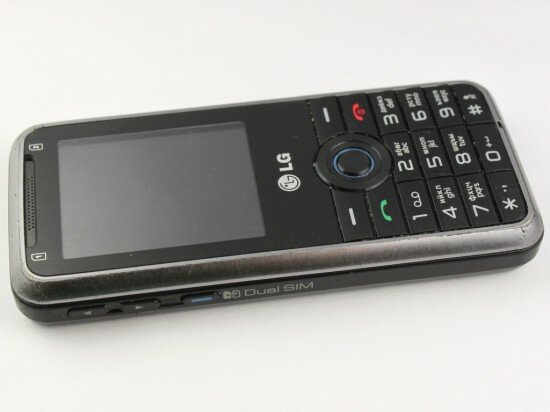
Рiс. 31. Here
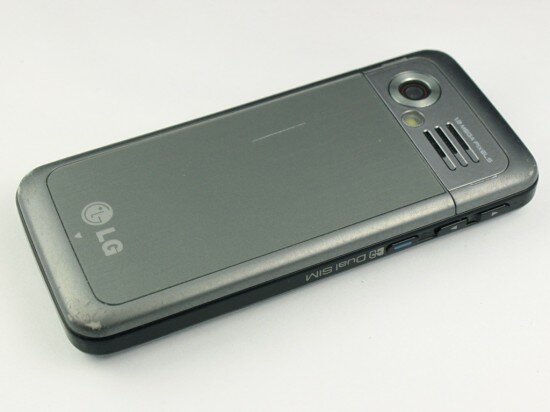
Рiс. 32. Here

 Russian version
Russian version